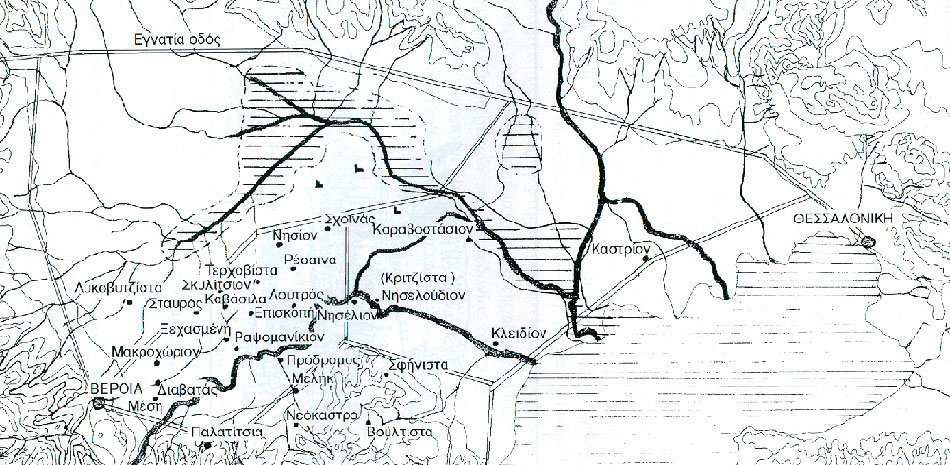At the beginning of the Byzantine era this fertile region belonged to rich landowners from Veria and Thessaloniki and at the same time there was a wide area cultivated by other farmers. The church became also powerful and soon owned a big area of land which was exploited by many monasteries that were built there. At the same time and in order to compensate many of the military, land was shared out to them in the region of Kampania.
The invasions of the Slavs during the 7th century caused great changes in Kampania, as many of them became residents of the plain. But the emperors relocated many of the Slavs from central Macedonia to Asia Minor as well as Roman population from Asia Minor to Kampania. There has been a great conflict between researchers about the see and the borders of the Episcopate of Drougouviteia and of course about the location of the Slavic settlements.
There is reliable information about the creation of the Episcopate of Kampania during the 10th century as well as about Veria and its eastern boundaries which reached down to the Axios River. The village Episkopi (in Greek episcopate) probably owes its name to the fact that it was the first see of this episcopate.
We can also find I. Kameniatis’ description of the plain. He speaks highly of the region and confirms the benefits for the economy of Thessaloniki due to fishing and inland navigation which connected the sea to the up-country regions. Aliakmonas and Loudias used to be navigable rivers at that time and through their estuary one could reach the lake of Loudia. “Karavostasi”, a place in the rural area of Platy, still reminds of the old port that used to exist there.

The route followed by the bulls that according to tradition transferred the coffin of saint Antonios (10th-11th century) gives information about the villages Diavatos, Kouloura, Mesi, Rapsomaniki, Xechasmeni and Stavros. It is also sure that the family of the Kavasilas from Thessaloniki, which is known since the 11th century, used to own a teamstery exactly at the same position where the village Kavasila of Imathia is located today.
In 1246 Ioannis Vatatzis settled in Kampania some of his Christianized allies (Seljuk Turks), descendant of Kaikus the 2nd. The village of Meliki was probably named after one of these allies, Konstantinos Astrapyris Melik, whose family used to own this region.
In 1309 a battle took place at the plain of Veria between Catalan mercenaries and the commander of Thessaloniki Handrinos. The Catalans were defeated and Macedonia as well as Mount Athos got rid of their plundering.
During the 14th century there were constant fights in the region of Kampania, conducted by I. Katakouzinos, who had occupied Veria and had conflicts with the army of the legal emperor. During that civil war Serbian and Turkish soldiers fought too and eventually had the chance to forward their expansionist policy. As a result, the region came for many years to the Serbian Stefanos Dousan due to the decline of the local Byzantine government.
Byzantine documents of this period confirm the existence of the villages Makrochori, Resaini (Vrysaki), Nisi, Meliki, Lykovitza (Lykogianni) and Palatitsia. There is also information about a “village of soldiers”, Kritzista (or Gritzista), which means the “village of the Greeks” and must have been located in Alexandreia-Platy.
Alexandreia of Imathia
Ioannis D. Moschopoulos
Lawyer
Researcher of History and Folklore